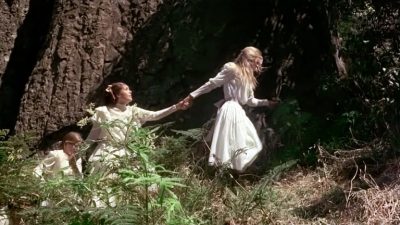Reviewer: Emera
Date read: 7.17.2020
Book from: Library
It was a cloudless summer day in the year 1900. Everyone at Appleyard College for Young Ladies agreed it was just right for a picnic at Hanging Rock. After lunch, a group of three girls climbed into the blaze of the afternoon sun, pressing on through the scrub into the shadows of the secluded volcanic outcropping. Farther, higher, until at last they disappeared. They never returned… Mysterious and subtly erotic, Picnic at Hanging Rock inspired the iconic 1975 film of the same name by Peter Weir. A beguiling landmark of Australian literature, it stands with Shirley Jackson’s We Have Always Lived in the Castle, Daphne du Maurier’s Rebecca, and Jeffrey Eugenides’ The Virgin Suicides as a masterpiece of intrigue.
As expected, this was a delicious summer treat – though it didn’t go down without some misgivings. On the whole, Picnic at Hanging Rock is satirical, dreamy, sensuous, and occasionally quite sinister and chilling—mainly in how Lindsay refers to the dark, inscrutable mass of the Hanging Rock brooding in the metaphysical distance behind or beyond the characters ever after the girls’ disappearance, the source of some kind of alien causality.
The book is also quite, quite gay. I was astonished by how Sapphic the movie is when I saw it back in undergrad, but the book is far more explicit than the movie’s languid, soft-focus erotic glow. The novel opens with five pages of the students and the prettiest teacher fluttering over their Valentine’s Day cards and take turns thinking about how much pleasure they derive from gazing at each other’s curls and bosoms and OH MY. Check it—this is from the perspective of Mademoiselle, the French teacher:
The girl’s voluptuous little breasts, her dimples, full red lips, naughty black eyes, and glossy black ringlets, were a continual source of aesthetic pleasure.
It’s also immensely “interesting” that the book’s only two male characters effectively end up riding into the sunset together. It may be that Lindsay largely intends the spiritual bachelorhood of young, wealthy Michael Fitzhubert as tragic: he’s positioned in a love quadrangle with the vanished Miranda (his true love, seen once and never recovered); Irma, the one returned girl (who regards Michael as her true love, but is spurned); and his best mate, the rough horseman Albert (who, finally, is in love with Irma). I found this love-quadrangulation silly as a romantic device, mainly because I found it hard to take any of the characters seriously – a point to which I’ll return later. I think what’s interesting about it is its alienating, distancing effect, the way that these four young people are strangely offset from one another, incapable of moving in the same space. This heightens, of course, the book’s central element of feminine-as-mystery. At one point, Michael even wonders to himself what “feminine secrets” were shared among the girls before they disappeared. Estranged from these unattainable, sometimes uncanny nymphs, Michael and Albert (hairy, tattooed, streetwise, occasionally lounging naked in Michael’s presence…) ride off into the optimism of undefined masculine adventures together.
Let’s return to the problem of how Lindsay handles her characters, generally. I think one of the book’s biggest weaknesses is that Lindsay treats the characters so archly that it comes off as self-satisfaction with her own satirical wit. Any dignity or intelligence the characters might have is often diminished by her heavy-handed descriptions. It doesn’t help that Michael, who is crushingly boring except for how he plays off of Albert, gets to occupy the middle third of the book with an immensely slow, inchoately mopey convalescence sequence. No, thanks. Luckily, Lindsay recovers from there with one of the book’s most climactically disturbing scenes, Irma’s final return to Appleyard College.
Continue reading Picnic at Hanging Rock, by Joan Lindsay (1967) E
